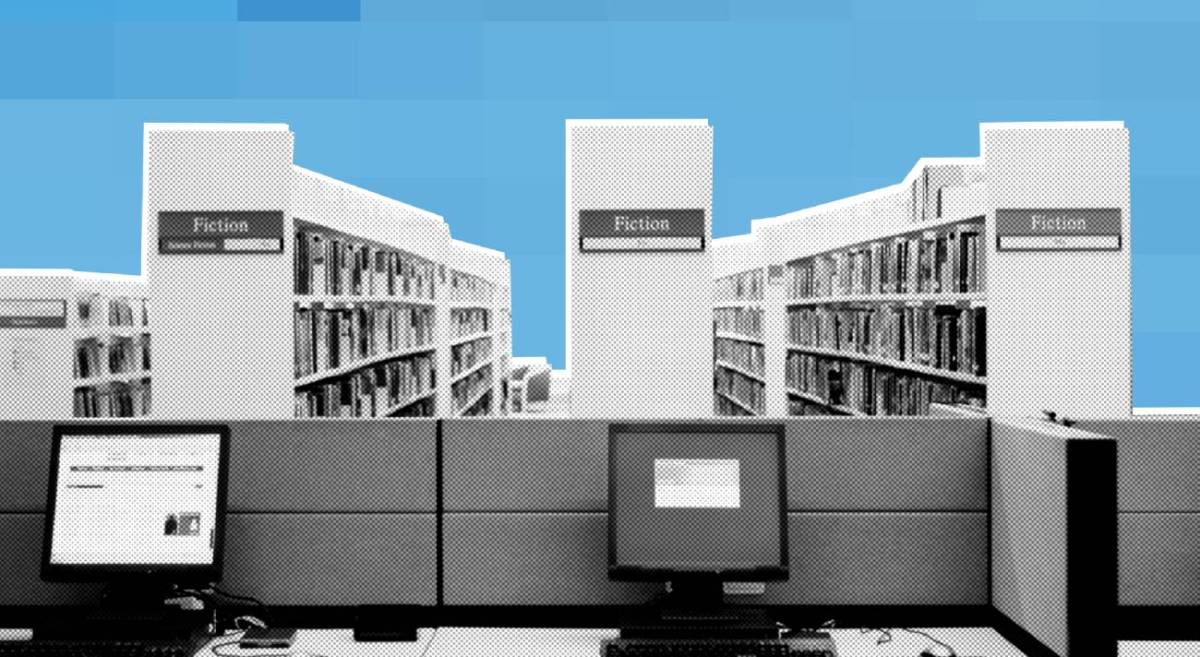Public libraries are alive and well, thanks to Gen Z, millennials and the shift to digital collections

There’s a common misconception that public libraries in America are dying, with the majority of naysayers basing a library’s successful operation on physical visits and loans of materials — books, journals and maps. It’s an easy mistake to make: In 2019, the average number of physical library visits dropped to fewer than four per year and material loans declined by 25%.
However, a 2023 report by the American Library Association found that Gen Z and millennials are changing the way public libraries serve their communities, especially as libraries expand their digital collections and services. It found Gen Z and millennials make up the largest cohort of library users across the United States.
The study found that 54% of people aged 13-40 visited physical libraries within the past year and 37% said they had used their library’s digital collection.
“We know that millennials, for example, are the most avid in terms of digital borrowing,” Rachel Noorda, the director of the book publishing program at Portland State University and one of authors of the ALA report, told StateScoop. “So they’re engaging with print books, which is actually their favorite format, but also digitally as well.”
Kathi Berens, an associate professor of digital humanities and book publishing at Portland State University, who also contributed to the report, said the most significant difference between how younger and older generations use public libraries is discovery.
Millennials and Gen Z grew up around technology, she said, which shaped their reading behavior, media preferences and how they learn about new books. The study found that 1 in 3 Gen Zers and millennials buy books based on recommendations from Instagram reviews and ads, and 31% buy books discovered from reviews on TikTok. That makes sense since 92% of both generations surveyed report checking social media daily, and 25% check multiple times an hour. Yet print books remain Gen Zers’ preferred format.
“So an example would be Bridgerton,” Berens said of the Netflix series that follows an aristocratic family in 19th-century England, based on the book series of the same name. “Bridgerton was a huge phenomenon on Netflix. Print sales shot up 3,000%, e-book sales went up 8,000%. So that’s really Gen Z and millennials saying, we saw this thing we liked, we want more.”
Similar to the book publishing industry, public libraries have faced a transitional period in recent years. To accommodate the decline of physical visits and physical book loans, libraries began increasing their digital collections, embracing their new technological landscape.
“It’s really critical that communities see digital library services as important for access,” Noorda said. “If we’re trying to offer the same number of books, for example, or increase the number in our digital collections because of increasing demand, then more funding needs to become available for the library to be able to meet that demand.”
From library to Libby
Berens and Noorda found that nearly 428 million electronic items were borrowed from public libraries in 2020. The rise is thanks to Libby, a free app that offers access to e-books, digital audiobooks and magazines from public libraries.
Libraries decide which digital titles they’d like to provide in Libby, which launched in 2017 but became more popular during the pandemic. Libraries also set their own lending policies, including how long titles can be borrowed and how much digital content users can borrow at a time. A valid library card is all that’s needed to use the app, an attractive deal to digital natives like Gen Zers and millennials.
“So from the Libby app, we know from their data that there’s been a 34% increase in digital borrowing since 2020, when people couldn’t actually get to their physical libraries,” Noorda said. “Now there’s even a bigger portion of folks who access e-books and audiobooks through their libraries and can do that regularly after the pandemic.”
Noorda said Libby also reduces wait times for borrowers, which can affect usage. Seventy-five percent of Gen Zers and millennials said a wait time of one week or less is “long.”
“The Libby app made digital borrowing instantaneous, as simple as getting books from any online vendor,” Berens said. “And I think that’s a pivotal moment in digital collection use.”
Though the pandemic accelerated the growth of digitizing public libraries, the report’s authors said the trend of expanding digital collections predates the health crisis.
Going digital
The Library Services and Construction Act of 1964 allocated federal funding for libraries, though mostly for construction of physical locations. But as personal computers, Wi-Fi, social media and streaming services appeared in recent decades, many public libraries found it difficult to keep up.
The Library Services and Technology Act, passed in 1996 during the Clinton administration, prioritized the creation of new technology infrastructure and closing the digital divide. It made federal funding available to public libraries across the country through the Institute for Museums and Library Services.
Sonia Alcantara-Antoine, president of the Public Libraries Association, an organization that represents and supports 17,000 libraries in the United States and Canada, started her career in public libraries in the early 2000s. She told StateScoop she remembers when digital catalogs were “state of the art” technology and that libraries gradually incorporated more tech over the years.
“We got computers for the public to use, then Wi-Fi became a thing, then our collections started to become accessible digitally,” Alcantara-Antoine said. “And so the same books that we were buying in print on the shelf, we would also add an e-book component or an audiobook component, and on and on and on.”
Alcantara-Antoine is also the chief executive of the Baltimore County Public Library system, working with an annual budget of $45 million, 35% of which goes to electronic resources like e-books, audiobooks and databases.
Lease, not own
Many public libraries face budgetary challenges when it comes to maintaining their digital collections to meet the media habits and preferences of Gen Zers and millennials.
Though digital media collections make public libraries more more accessible, it’s actually more expensive for libraries to acquire digital assets than physical materials. That’s because digital access equates to leasing agreements with publishers, not outright ownership – similar to buying a movie through an app versus owning a physical copy.
“When, when you buy a print book, you can do pretty much what you want, right? You can highlight it, you could tear out every other page, you could lend it to 20 different friends, you can sell it on eBay — you can do lots of things with a print book other than photocopy and mass produce it,” Alcantara-Antoine said. “There are a lot more restrictions that are put in place for e-books.”
She said publishers can limit the number of times e-books can be digitally checked out, the number of people who can borrow a given book or how many people can have access to a single piece of media simultaneously. Public libraries also have to worry about contracts expiring, in which case they may have to repurchase their leasing rights, sometimes at a higher cost.
In 1992, printed material accounted for more than 95% total collection size at public libraries. Three decades later, digital materials now compromise 58% of their collections.
“The data consistently shows that people continue to use public libraries. They just use us in different ways through each successive generation, and libraries are evolving to meet those needs,” Alcantara-Antoine said.
Other funding efforts
In 2021, libraries became eligible to receive more than $360 billion of the $1.9 trillion in recovery funding offered by the American Rescue Plan Act. That included $200 million for the Institute of Museum and Library Services, the largest single investment in the agency’s 25-year history.
The recovery act also included more than $7 billion for an Emergency Education Connectivity Fund through the Federal Communications Commission’s E-Rate program, which reimbursed libraries for the cost of loan devices like modems, routers, laptops and tablets.
Julius C. Jefferson, Jr., the ALA’s former president, praised the American Rescue Plan for reacting to the needs of libraries and their patrons.
“The pandemic has exposed the level to which Americans rely on libraries to access the internet and learn to navigate it, find jobs and gain new skills, learn to read and identify what information to trust, and become actively engaged in their communities,” he said in 2021. “Libraries are a lifeline for millions of people, and the people who know that best are those who need this rescue package most.”
By 2022 things had changed: 224 million people logged a session that year on one of 300,338 computers in the nation’s public libraries.

This story was featured in StateScoop Special Report: Digital Services — A StateScoop Special Report



